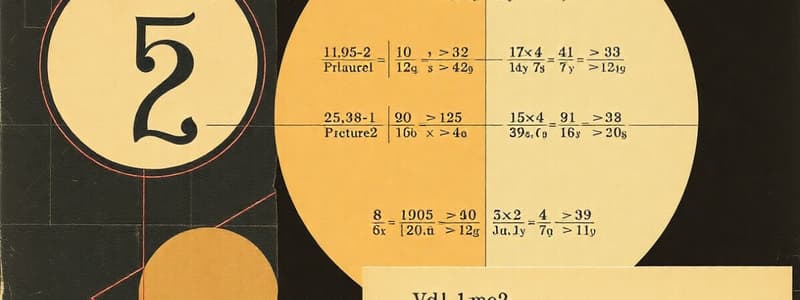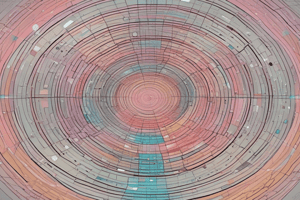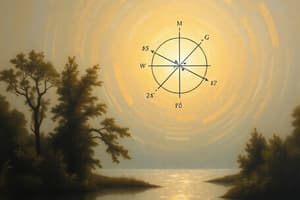Podcast
Questions and Answers
The area of a rectangle is calculated by multiplying its length by its height.
The area of a rectangle is calculated by multiplying its length by its height.
False (B)
What is the volume formula for a cylinder?
What is the volume formula for a cylinder?
$ ext{π}r^2h$
The volume of a cuboid is found by multiplying the length, width, and ______.
The volume of a cuboid is found by multiplying the length, width, and ______.
height
Match the following shapes with their respective area formulas:
Match the following shapes with their respective area formulas:
Flashcards
Area of a Circle
Area of a Circle
The total space enclosed by the circle's boundary.
Circumference of a Circle
Circumference of a Circle
The distance around the circle's boundary.
Volume of a Cube
Volume of a Cube
The amount of space a cube occupies.
Volume of a Prism
Volume of a Prism
Signup and view all the flashcards
Volume of a Cylinder
Volume of a Cylinder
Signup and view all the flashcards
Study Notes
Area of a Circle
- The area of a circle is the region enclosed by the circumference.
- Formula: Area = πr², where 'r' is the radius of the circle and π (pi) is approximately 3.14159.
- Example: If a circle has a radius of 5 cm, the area is π * 5² = 25π ≈ 78.54 square centimeters.
Circumference of a Circle
- The circumference is the distance around the circle.
- Formula: Circumference = 2πr, where 'r' is the radius.
- Example: A circle with a radius of 7 cm has a circumference of 2π * 7 = 14π ≈ 43.98 cm.
Volume of a Cube
- A cube has six square faces of equal size.
- Formula: Volume = side³ where 'side' represents the length of one side.
- Example: A cube with a side length of 4 cm has a volume of 4³ = 64 cubic centimeters.
Volume of a Prism
- A prism has two identical parallel bases connected by rectangular faces.
- Formula: Volume = Area of base * height.
- Example: A prism with a triangular base of area 10 square cm and a height of 6 cm has a volume of 10 * 6 = 60 cubic cm.
Volume of a Cuboid
- A cuboid has six rectangular faces.
- Formula: Volume = length * width * height.
- Example: A cuboid with length 5 cm, width 3 cm, and height 2 cm has a volume of 5 * 3 * 2 = 30 cubic cm.
Volume of a Cylinder
- A cylinder has two circular bases connected by a curved surface.
- Formula: Volume = πr²h, where 'r' is the radius of the circular base and 'h' is the height of the cylinder.
- Example: A cylinder with a radius of 2 cm and a height of 10 cm has a volume of π * 2² * 10 = 40π ≈ 125.66 cubic cm.
Area of a Square
- A square has four equal sides and four right angles.
- Formula: Area = side².
- Example: A square with a side length of 6 cm has an area of 6² = 36 square cm.
Area of a Rectangle
- A rectangle has four right angles and opposite sides that are equal in length.
- Formula: Area = length * width.
- Example: A rectangle with a length of 8 cm and a width of 4 cm has an area of 8 * 4 = 32 square cm.
Area of a Triangle
- A triangle has three sides and three angles.
- Formula: Area = ½ * base * height.
- Example: A triangle with a base of 10 cm and a height of 5 cm has an area of ½ * 10 * 5 = 25 square cm.
Area of a Trapezium
- A trapezium has one pair of parallel sides.
- Formula: Area = ½ * (sum of parallel sides) * height.
- Example: A trapezium with parallel sides of 6 cm and 10 cm, and a height of 4 cm has an area of ½ * (6 + 10) * 4 = 32 square cm.
Area of a Parallelogram
- A parallelogram has two pairs of parallel sides.
- Formula: Area = base * height.
- Example: A parallelogram with a base of 12 cm and a height of 7 cm has an area of 12 * 7 = 84 square cm.
Area of a Kite
- A kite has two pairs of adjacent sides that are equal in length.
- Formula: Area = ½ * product of diagonals.
- Example: A kite with diagonals of 8 cm and 6 cm has an area of ½ * 8 * 6 = 24 square cm.
Arcs and Sectors
- Arc: A portion of the circumference of a circle.
- Sector: A region bounded by two radii and an arc.
- The area of a sector depends on the central angle and the radius of the circle.
- Formula for area of a sector: (θ/360) * πr², where θ is the central angle in degrees, and 'r' is the radius.
- Example: A sector with a central angle of 60 degrees and a radius of 4 cm has an area of (60/360) * π * 4² = (1/6) * 16π ≈ 8.38 square cm.
Studying That Suits You
Use AI to generate personalized quizzes and flashcards to suit your learning preferences.




